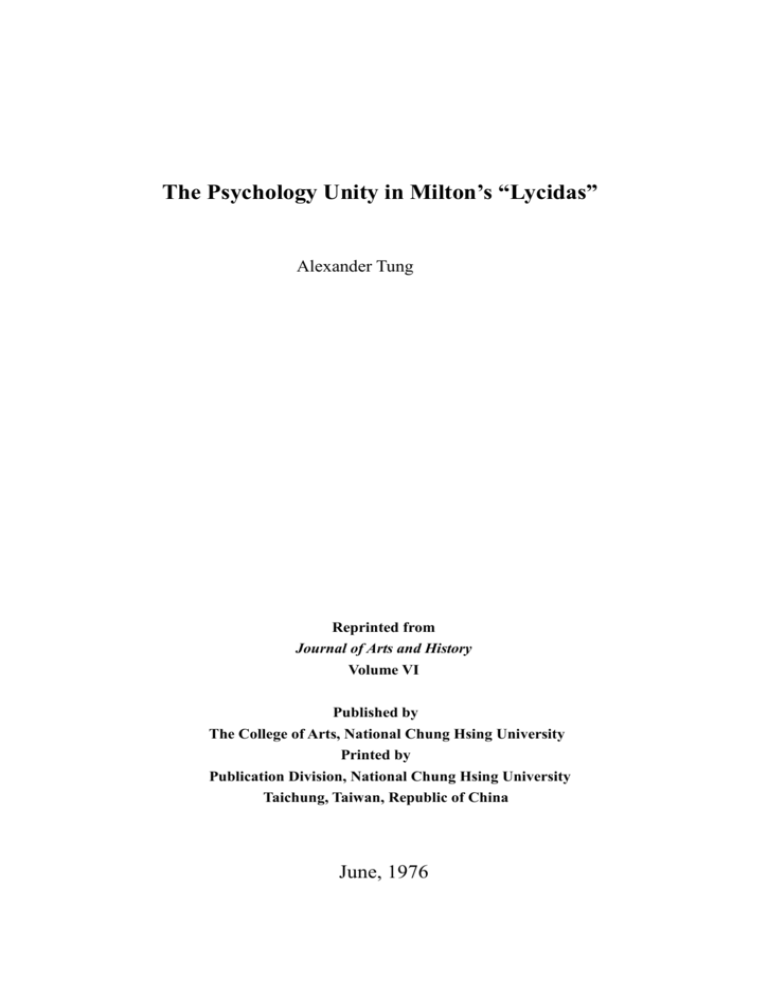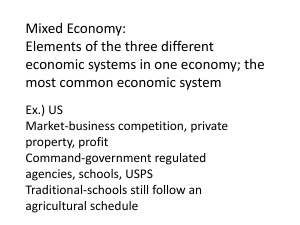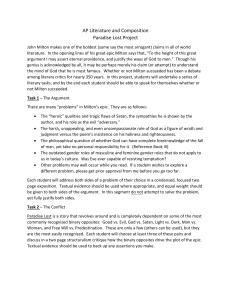The psychological Unity in Milton`s “Lycidas”
advertisement

The Psychology Unity in Milton’s “Lycidas” Alexander Tung Reprinted from Journal of Arts and History Volume VI Published by The College of Arts, National Chung Hsing University Printed by Publication Division, National Chung Hsing University Taichung, Taiwan, Republic of China June, 1976 The Psychological Unity in Milton’s “Lycidas” Since Dr. Johnson’s charge of insincerity, critics of Milton’s “Lycidas” have gone one step further to cast their stones at its unity. In consequence, many readers nowadays will conclude easily with G. W. Knight that “Lycidas” is simply “an accumulation of magnificent fragments” (70). Of course, conclusions like this are not drawn without reason; they can be justified in their own right. However, insofar as we are concerned with the unity of a work, especially with the crucial question of whether there is unity or not existing in such a famous work as Milton’s “Licidas,” it may behoove us to keep “exploring” the work (as a scientist does his planet) before we make our final declaration. For a work can be unified “by any means which can so integrate and organize its elements that they have a necessary relationship to each other” (Holman 500). Where the surface structure of a work fails to show any unifying agent, there may be some underlying element which, upon our close examination, may prove to be a powerful means to glue all the pieces together. When we read a stream-of-consciousness novel, for instance, we may easily be struck with its seemingly chaotic sequence of narratives. Not infrequently, however, we can sense lurking behind the surface structure of that work a psychological thread which does serve to string its seemingly non-correlated parts together. Thus, what is fragmental at first glance may prove quite integral at last. Returning to our discussion of Milton’s “Lycidas,” we find the poem is just like a stream-of-consciousness novel in this sense: it manifests no smooth and continuous movement unless we probe into its inner psychological structure. Perhaps the greatest difference in this connection is: whereas what flows in a stream-of-consciousness novel is the stream of a certain character’s consciousness (Stephen Dedalus’s or Mrs. Dalloway’s), what flows in “Lycidas” is, as will soon be discussed below, the stream of the poet Milton’s consciousness. And, therefore, to fully appreciate the work--especially to see it as a coherent whole instead of disparate segments--some knowledge of the poet, especially of his psychological background, becomes necessary.1 We all know that the death of Edward King, Milton’s “learned Friend,” is the occasion of the poem. But it is to be noted that before he was drowned, King was prepared to qualify himself for the ministry and was considered a poet, too. Besides, at the time of King’s death Milton had been at home for five years, “engaged mainly in laying a foundation in humane knowledge and thought for his unknown future” (Hughes 545). Under such circumstances, the news of King’s sudden death naturally would lead Milton to reflect upon his own past intentions of entering the ministry and his hopes of writing a great poem.2 Graves’s comment upon the situation is a little too frankly bitter, but none the less to the point: Milton was obsessed by thoughts of his own fame. His strongest reaction to the news of Lycidas’s drowning was: “Heavens, it might have been myself! Cut down before my prime, cheated of immortal fame!”3 Indeed, it is by no means an oversimplification to say that King is only “a surrogate for Milton himself” (Hamford 1949, 69). In no other English elegies (e.g., Shelly’s “Adonais” or Tennyson’s In Memoriam) do we find so much pain felt for the mourner as well as for the mourned. In reading the elegy, one might feel that Milton was really insincere in “bewailing” his learned friend. Yet, one would definitely never feel that Milton was insincere in mourning for himself. That is why we find, with the exception of a few lines (ll.23-36), little mention or description of King’s life or personality in the poem, but instead we find Milton laboriously emitting therein a succession of willful passions (some of which are even totally irrelevant, e.g., the digression from l. 110 to l. 131) by the use of both pagan and Christian allusions as well as pastoral images, which reveal and represent merely the poet’s great learning and thought. Woodhouse is right in saying that “the principal source of the poem’s extra-aesthetic emotion is not grief for the loss of Edward King, but an awareness of the hazards of life and of Milton’s own situation.”4 And we would be equally right in postulating that more than most other English works the poem is built on the basis of the poet’s own psychology. If the psychology in this poem is Milton’s, we should then read the poem with Milton always in mind. First, we should know that Milton is an erudite scholar fully familiar with classical works and therefore spellbound by their conventions. So, when he chooses to write the “Monody” (virtually a pastoral elegy), to ask him not to use multitudinous allusions and pastoral images is “to ask the painter not to dip in the colours of the rainbow, if he could.”5 With this understanding, we should then disregard Dr. Johnson’s ingenious remark that “where there is leisure for fiction there is little grief” (see Elledge 229), and take instead Thomas Newton’s that “grief is eloquent” (see Elledge 227). Next, we should know that Milton is a serious Christian. So, although he is deeply imbued with classical humanism, he does not forget its limitations within the terms of the Christian vision.6 Hence we should not be surprised to find St. Peter and Christ introduced into the elegy, nor should we deem it merely intrusive, and therefore nonsensical, verbosity for Milton to “foretell the ruin of our corrupted clergy then in their height” in the elegy.7 Indeed, it is likely that “Lycidas” is Milton’s first attempt to “assert eternal Providence and justify the ways of God to men” (Allen 84). For as we read carefully on, we can really find, to quote Sands’s words, that throughout the work, “there appear overtones of profound spiritual struggle, as well as a strong doubt, barely resolved at the end, concerning the possible uselessness and vanity of the hard consecrated life” (13). In fact, these two basic facts about Milton himself (his being a classical scholar and his being a serious Christian) serve to explain why “Lycidas” is an “architectural and willed” work (Belloc 118). A scholar naturally will make his work artistic, hence “architectural”; a Christian naturally will make his work preachy, hence “willed.” In “Lycidas” we find the architecture is based on the conventions of pastoral elegy: a history of past friendship, a questioning of destiny, a procession of mourners, a laying-on of flowers, a consolation, etc., presented through the mouth of the poet as a shepherd. And the will is based on the Christian beliefs that fame exists in Heaven, the “two-handed engine at the door/Stands ready to smite once, and smite no more,” (ll. 130-31), a good man will not be “sunk low, but [will be] mounted high” (l. 172) by death, etc. These conventions and beliefs, when molded into a single work, naturally will seem heterogeneous outwardly. But inwardly if we inspect their links, they will only appear to be a homogeneous whole. For example, we all agree that there are three major movements in this poem. And, as Wayne Shumaker believes, the most consummate analysis of them is Arthur Barker’s: The first movement laments the poet-shepherd; its problem, the possible frustration of disciplined poetic ambition by death, is resolved by the assurance, “Of so much fame in heaven expect thy meed.” The second laments Lycidas as priest- shepherd; its problem, the frustration of a sincere shepherd in a corrupt church, is resolved by St. Peter’s reference to the “two-handed engine” of divine retribution. The third concludes with the apotheosis, a convention introduced by Virgil in Eclogue V but significantly handled by Milton. He uses the poet-priest-shepherd worshipping the Lamb with those saints “in solemn troops” who sing the “unexpressive nuptial song” of the fourteenth chapter of Revelation. The apotheosis thus not only provides the final reassurance but unites the themes of the preceding movements in the ultimate reward of the true poet-priest. (94-95) Certainly the final movement of the apotheosis “unites the themes of the preceding movements in the ultimate reward of the true poet-priest.” But the way it unites them-- “the ultimate reward of the true poet-priest”--is characteristic of Milton’s concept, of his religious faith. In his mind every human frustration or despair can be swept away by religious faith; so long as there is faith, there is hope. This is his inner psychology. And it finds an outlet not only in this work, but in many others. For example, the last part of his greatest work Paradise Lost also has the same idea. When Adam and Eve are in utter despair, Christ comes to assure them that paradise can be regained through their faith in God. So, we can say Apollo’s words and St. Peter’s words, as well as the apotheosis, are but different expressions of Milton’s same religious faith. Accordingly, the three movements have but one theme. And it is as Grierson puts it: “the personal resolve, the life-long aspiration, with its attendant fluctuation of hopes and fears, expressed by Milton in the seventh prolusion, in the sixth elegy, in the sonnet on his twenty-third birthday, and now most recently in the letter to Diodati” (69). Or to state it simply, it is the transition from human despair to hope through religious faith. In effect, the transition from the mood of despair to that of hope is best expressed in the language of the poem, especially in its imagery and diction. For instance, at first we see the vegetation imagery is completely tinged with the color of melancholy and disorder, thus suggesting despair (as when Eden is lost): the myrtles are brown; the berries harsh and crude; the thyme wild; the vine gadding and overgrown; most flowers are damaged by the frost while the ‘sanguine flower inscrib’d with woe,” and the rose killed by the canker; and the willows and the hazel copses are not green any more. Likewise, at first the water imagery suggests a stagnant and lifeless quality: Mincius slides smoothly; the brine is level; Camus goes “footing slow,” and “inwrought with figures dim.” Other images, too, firstly only express their despairing aspects: Lycidas has to “welter to the parching wind”; the “top of Mona high” is shaggy; “the weanling herds that graze” are subject to the killing of the taint-worm. And together with these images and other descriptions are the dismal adjectives used to reinforce the despairing impression: sere, bitter, sad, sable, heavy, desert, remorseless, hideous, gory, felon, hard ,rugged, beaked, fatal, perfidious, dark, etc. But after the reassurance of Apollo and St. Peter, hopeful images and diction gradually blend into the description. A catalogue of flowers with “a thousand hues” is brought forth to “interpose a little ease.” The seas are “sounding” with life; the brooks “gushing”; the tide “whelming.” And words with good connotations begin to appear: quaint enamell’d, honied, vernal, rathe, glowing, well-attir’d, newspangled, pure, nuptial, meek, dear, joy, love, sweet, glory, fresh, new, etc. Indeed, “all is color and motion as the brooding melancholy of the poet is swept away” (Belloc 68). Despair has been changed into hope. So, echoing the theme, the imagery and the diction also suggest a consistent pattern of moods which are no longer variously “pathos, indignation, [ and ] reassurance” (Grace 143), but are simply “one mood, one overriding tension, transcending and reconciling opposites” (Grace 144) composed of despair and hope which are the “faithful Herdman” Milton’s own inner psychological responses to the stimulus of King’s sudden death. In his The Shadow of Heaven, Jon S. Lawry wittingly observes that the mood of “Lycidas” “is to be agonically thoughtful, thought is to be its subject, and mood and subject will be conveyed in language simple, sensuous, and passionate” (97). It is true that the mood of “Lycidas” is, as an elegy often is, agonically thoughtful. But the agony is felt as much for Milton himself as for King; and the thought is centered more on the former than on the latter. Consequently, the mood and the subject can be directly drawn from Milton’s own psychology. As discussed so far, the subject is Milton’s usual subject: the mutation of human despair into hope through religious faith. Following that subject, the mood is that of his struggling between despair and hope. And in turn following that mood, the language--especially the imagery and diction--also shows his transition from despair to hope, be it “simple,” or “sensuous,” or “passionate.” So we see the work manifests a perfect unity in its content and expression when viewed in the perspective of Milton’s own psychology. It follows then that the work should not be censured for “lack of unity.” And if unity is a necessary and laudable element for a work, one should not trace it merely in the surface structure of the work. For as already said, a work may be unified by any means. As in the case of Milton’s “Lycidas,” we find the poem is somewhat like a stream-of-consciousness novel: its unifier lies not in its surface structure but in somebody’s consciousness (and here in the poet Milton’s consciousness). So, some knowledge of the author’s inner psychology becomes necessary to fully appreciate the work. And G. W. Knight, I think, is one of those who have neglected the importance of Milton’s psychology in understanding “Lycidas.” Notes 1. Hereby I would like to emphasize in passing that although supporters of the so-called New Criticism are right in stressing the intrinsic worth of literature, there are cases (and “Lycidas” is one) when we have to admit with Dr. Johnson that without knowing the author one would be unable to appreciate the work. 2. 3. 4. 5. 6. 7. See, on this point, Grierson’s Milton and Wordsworth, p. 92. See Elledge’s Milton’s “Lycidas”, p. 248. See Hughes,, Vol. 2, p.593. William Hazlitt’s remark. See Elledge, p. 232. See, on this point, Grace, p. 141. It is said that Milton was induced to add the second sentence “And by occasion foretells … height” to the originally one-sentence epigraph by the attack on episcopacy, which began with the meeting of the Long Parliament in 1640. But the fact remains that Milton was a serious Christian and so he could be induced to do so. See Hughes, p. 637. Works Consulted Allen. Don Caneron. The Harmonious Vision: Studies in Milton’s Poetry. Baltimore: Johns Hopkins UP, 1954. Belloc, Hilaire. Milton. Philadelphia: J. B. Lippincott Co., 1935. Elledge, Scott, ed. Milton’s “Lycidas.” New York: Harper & Row, 1966. Grace, William J. Ideas in Milton. London: U of Notre Dame P, 1968. Grierson, J. C. Milton and Wordsworth. London: Chatto & Windus, 1963. Hamford, James Holly. John Milton, Englishman. New York: Crown Publishers, 1949. ----------. A Milton Handbook. 4th ed. New York: F. S. Crofts & Co., 1946. Holman, C. Hugh. A Handbook of Literature. New York: The Odyssey Press, 1968. Hughes, Merritt Y., ed. A Variorum Commentary on the Poems of John Milton. Vol. II. New York: Columbia UP, 1972. Knight, G.. W. The Burning Oracle. London: Methuen, 1939. Lawry, Jon S. The Shadow of Heaven: Matter and Stance in Milton’s Poetry. Ithaca, NY: Connell UP, 1968. Rudrum, Alan, ed. Milton: Modern Judgements. London: Macmillan & Co., 1968. Sands, Maurice. An Outline of Milton. Students Outline Company, 1956.







